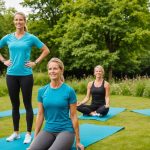Essential Flexibility Exercises for Seniors in the UK
Flexibility exercises for seniors are vital for maintaining mobility and independence. Regular stretching for the elderly helps prevent stiffness and supports joint health, making daily activities easier.
Start with gentle neck stretches. Slowly tilt your head toward each shoulder, holding for 15 seconds. This relieves tension and increases neck flexibility.
Also to discover : Enhancing emotional wellness: a guide for seniors in the uk
Next, shoulder rolls improve upper body movement. Roll your shoulders forward in a circular motion 10 times, then reverse. These enhance blood flow and reduce stiffness common in senior fitness UK routines.
Seated hamstring stretches are crucial. While sitting on a chair, extend one leg straight and reach toward your toes, holding for 20 seconds. This stretch supports lower back health and eases walking.
Also to read : Top strategies for uk seniors to minimize chronic disease risks
Remember, the importance of stretching lies in consistency. Even five minutes daily can boost flexibility, prevent falls, and enhance overall wellbeing.
Incorporating these flexibility exercises into a senior fitness UK plan fosters strength and balance. Over time, seniors will notice improved posture, reduced pain, and greater freedom in movement—all essential for active living.
How to Perform Flexibility Exercises Safely
Ensuring safe exercise for seniors requires attention to several important factors. Before beginning any new flexibility routine, consult a healthcare provider, especially if you have pre-existing health issues. Warm up gently to prepare muscles, reducing the risk of injury. Slow, controlled movements are vital—avoid bouncing or forcing stretches, which can lead to strains.
Recognizing signs that indicate you should pause or stop exercising is crucial for injury prevention. Persistent pain, dizziness, or excessive shortness of breath are red flags. If these symptoms occur during a session, stop immediately and rest. Gradual progression avoids overexertion, making flexibility training safer and more effective.
Tailoring exercises to individual health conditions supports safety for elderly fitness. For example, those with arthritis may need to modify stretches to avoid joint strain, while individuals with osteoporosis should avoid aggressive bending or twisting. Using props like chairs or straps can enhance stability and flexibility benefits without compromising safety. Always listen to your body and prioritize comfort over intensity to maintain a safe, enjoyable routine.
Integrating Flexibility Exercises into Daily Life
Incorporating exercise routines for seniors focused on flexibility can noticeably improve daily mobility and overall independence for the elderly. A sustainable routine begins with setting realistic goals and choosing gentle stretches that can be done regularly without strain. For example, adding simple stretches during routine activities, such as calf raises while waiting for the kettle or shoulder rolls during television commercials, transforms everyday moments into valuable mobility opportunities.
Consistency is key to maintaining these small but impactful habits. Seniors may find motivation by linking stretches to already established daily rituals, making exercise a natural part of their day. Additionally, tailoring routines to individual needs ensures exercises feel rewarding rather than burdensome. Family support or joining group classes can further encourage regular participation, reinforcing the positive effects on flexibility and balance.
By committing to manageable and enjoyable flexibility exercises, seniors can enhance their independence for the elderly, reducing stiffness and easing movement challenges. This holistic approach to daily mobility tips not only boosts physical health but also uplifts confidence, making life’s everyday activities safer and more enjoyable.
Trusted UK Resources and Support for Senior Fitness
Ensuring safe and effective senior fitness support UK starts with following the NHS exercise guidelines. The NHS recommends that older adults engage in at least 150 minutes of moderate-intensity aerobic activity weekly, combined with muscle-strengthening exercises on two or more days. These recommendations aim to improve mobility, balance, and overall health.
Access to guided routines is crucial. Many community centers across the UK offer exercise classes for older adults, providing social engagement along with physical benefits. These locally led classes often tailor movements to cater to varying mobility levels, enhancing safety and effectiveness.
For those preferring home workouts, reputable online platforms endorsed by UK health organizations present clear demonstrations. These digital resources complement in-person classes and adhere closely to NHS standards, ensuring older adults receive appropriate guidance without risk.
By combining these trusted resources, seniors can confidently embrace exercise, making fitness a sustainable part of daily life. Exploring a blend of community and online options ensures accessibility and motivates continual engagement with fitness routines designed for longevity and well-being.








